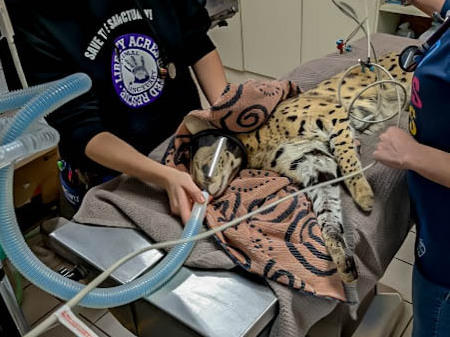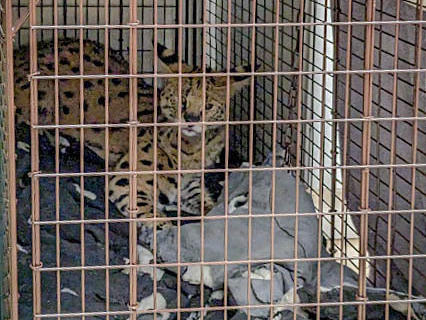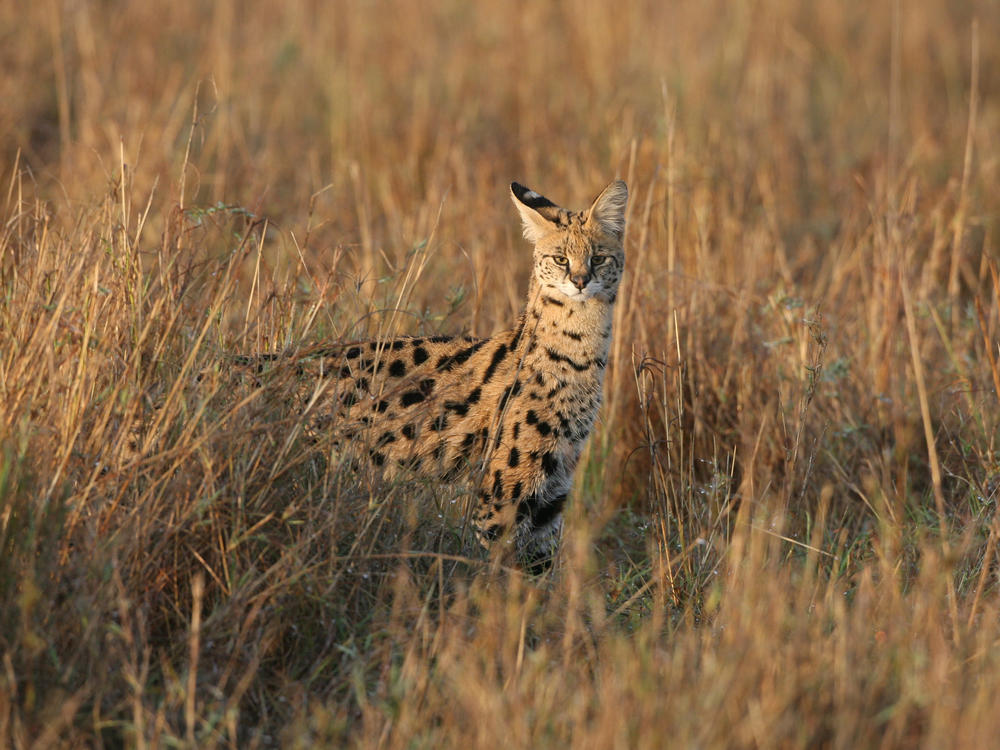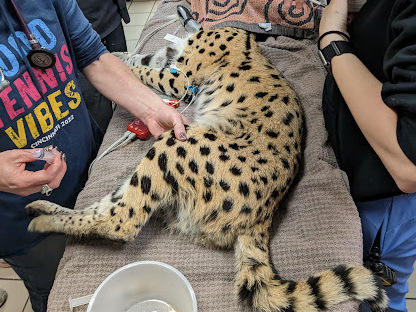Section Branding
Header Content
A wild cat was found in Cincinnati with cocaine in its system. No, it's not a movie
Primary Content
Updated March 10, 2023 at 5:03 PM ET
You've probably heard of Cocaine Bear, the box-office hit about a black bear's drug-fueled feeding frenzy. But have you heard of "cocaine cat?"
The phrase started trending on Twitter on Thursday. Like the movie, it's based on a true story — only this one is about a wild cat that was captured in Cincinnati and turned out to have cocaine in its system.
Unlike the movie, this story isn't set in the 1980s — it happened earlier this year. It was only made public recently for legal reasons, explains Ray Anderson with the Cincinnati Animal Care shelter.
"Coming on the heels of the Cocaine Bear movie, we're not surprised it has gone viral," he told NPR via email.
The protagonist of this particular tale is a serval named Amiry.
The capture
The big cat was kept as a pet and escaped from his owner's car during a police stop in January, according to Anderson.
That's when Hamilton County Dog Wardens (a division of Cincinnati Animal Care) got calls about what was thought to be a leopard spotted up in a tree.
Responders were able to retrieve Amiry and bring him back to the shelter, where the medical team called in an expert (whose credentials include working on the "Tiger King" case and the Zanesville tragedy) to identify his species.
The expert suspected Amiry was actually a serval, a long-legged, big-eared wild cat that is native to sub-Saharan Africa and illegal to own in Ohio. To confirm that, the medical team took a DNA sample — and also tested him for narcotics.
"Amiry tested positive for exposure to cocaine and the DNA test concluded he was indeed a serval," Anderson wrote.
The cocaine
Why did the shelter test Amiry for drugs in the first place? The short answer is a capuchin monkey named Neo.
Last year, local animal control seized the monkey from his Cincinnati home after a veterinarian who saw videos of him believed he had ingested Xanax and/or cocaine and was in need of medical care.
Neo tested positive for amphetamines, underwent treatment and is now "safely in an undisclosed location," according to Anderson. His owner was indicted on animal cruelty charges.
Since then, Anderson says it's become standard protocol for the shelter to test for narcotics for any animal that is more "exotic" than the usual household pet.
"Of course, we also test for narcotics on any dog or cat displaying behaviors that would lead us down that path," he added. "Amiry was extremely agitated at the time he was with us, which is understandable given what he had been through that morning, but we were able to sedate and treat before transporting to the [Cincinnati] Zoo."
Anderson declined to elaborate on the specifics of the toxicology report, and said authorities are still looking for specific evidence that would indicate how the cocaine got into Amiry's system.
"Given the nature of his capture, we cannot currently say if this intentional or environmental," he added.
The cat
The shelter that rescued Amiry is not equipped to house wildlife, so it sent him to the Cincinnati Zoo and Botanical Garden after a few days.
Anderson acknowledged it can be difficult to find placement for servals and credits the zoo for helping the shelter out of a tough spot.
"Our top priority was getting Amiry safely and legally placed as quickly and efficiently as possible," Anderson said.
Amiry has been recovering from a broken leg, an injury he sustained while slipping out of the tree during his dramatic rescue.
Zoo officials said in a statement on Friday that his health had improved enough for him to move to the area of the Cat Ambassador Program, which aims to educate visitors about the importance of wild cat predators and raise money for cheetah conservation efforts.
The team there will monitor his recovery and help him acclimate to a new environment, a process they say is off to a promising start.
"Amiry is young and very curious. He is exploring his new space and eating well, both great signs of progress," said Linda Castañeda, the lead trainer of Cincinnati Zoo's Cat Ambassador Program. "We are working on building trust and increasing his comfort as he adjusts to his new home."
The case
Amiry's owner willingly signed Amiry over to animal authorities and has cooperated with their investigation, Anderson said, which is why they are not pursuing charges at the time.
"His owner was cooperative and paid for Amiry's care until all ownership transfers were finalized, which is when this story went public," Cincinnati Animal Care noted in a Facebook post on Thursday.
However, it says the case remains open pending additional evidence and that the Ohio Department of Agriculture is investigating as well.
The Hamilton County Dog Wardens are asking anyone with information to call them at 513-541-7387.
The conclusion
There have been a number of recent instances of wild animals gone, well, wild in the U.S.
A pair of emperor tamarin monkeys were stolen from (and returned to) the Dallas Zoo in January, while an Eurasian eagle owl escaped from the Central Park Zoo last month (and remains free to this day). Plus, Cocaine Bear.
That's not necessarily cause for concern, but Anderson advises caution. If you do happen to encounter an exotic or agitated animal, keep your distance as much as possible and contact local animal control.
"Do not approach, do not wait to get pictures or videos, stay safe as it could not only be a life or death situation for yourself, but the animal as well," he added. "Let professionals handle the situation and get the animal to safety if possible."
There's another lesson his organization wants people to take away from Amiry's story, as it wrote on Facebook.
"We remind our community that there will be thousands of dogs, cats, and other animals in need of rescue entering our facility this year who will not receive this level of publicity," it wrote, urging people to visit their county animal shelter when searching for their next pet.
Copyright 2023 NPR. To see more, visit https://www.npr.org.




